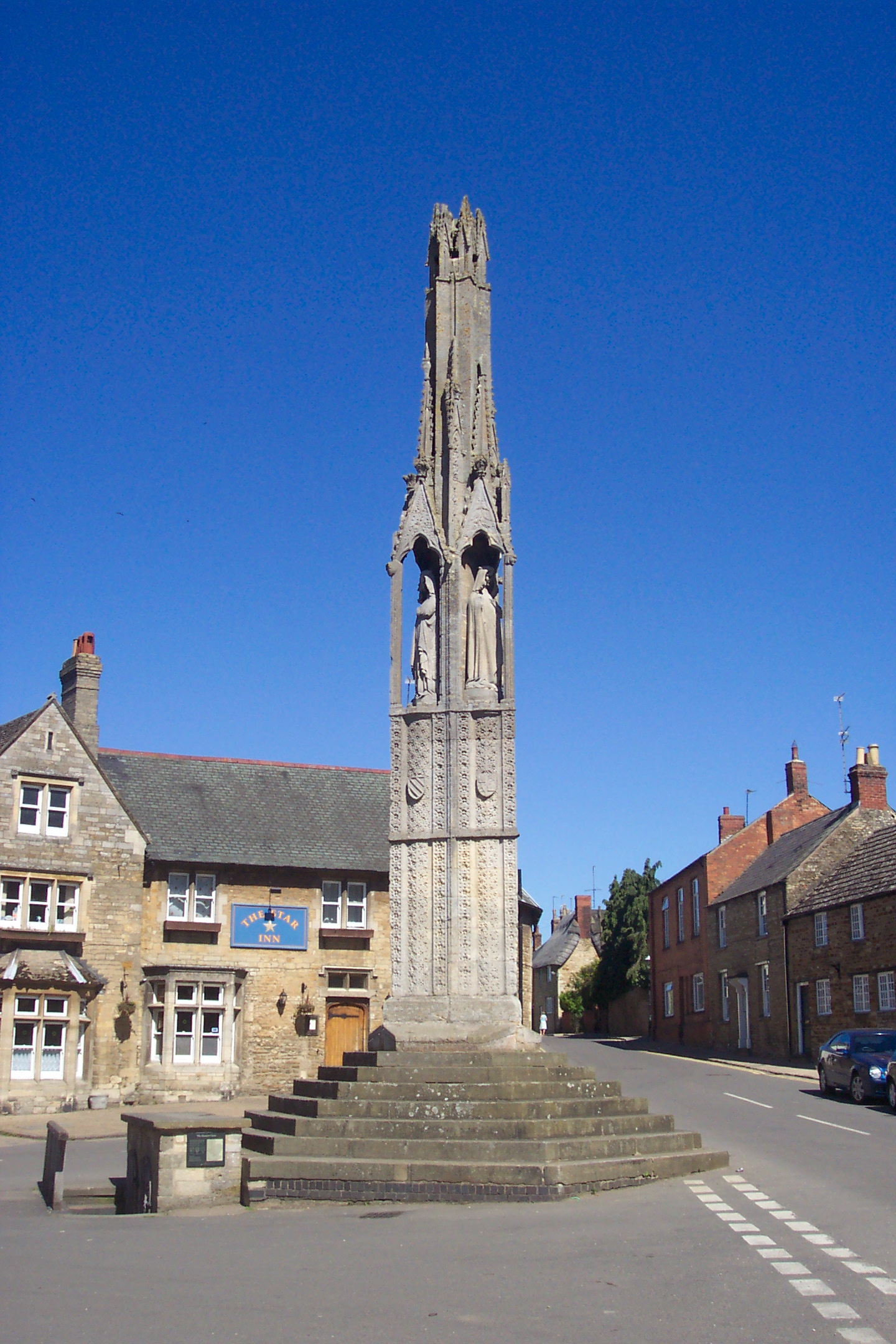The Eleanor crosses are a series of twelve tall and lavishly decorated stone monuments topped with a cross, built in a line down part of the east of England. King Edward I had them erected between 1291 and about 1295 in memory of his wife Eleanor of Castile, who died in November 1290 at Harby in Nottinghamshire, while the King and Queen were on their way to Scotland. The crosses were erected in each of the nightly resting places along the route taken when her body was transported to London. They stood at Lincoln, Grantham and Stamford, all in Lincolnshire; Geddington and Hardingstone in Northamptonshire; Stony Stratford in Buckinghamshire; Woburn and Dunstable in Bedfordshire; St Albans and Waltham (now Waltham Cross) in Hertfordshire; Cheapside in London; and Charing (now Charing Cross) in Westminster. Three – those at Geddington, Hardingstone and Waltham Cross – have survived more or less intact, but the other nine, except for a few fragments, are lost.
The largest and most ornate of the twelve was Charing Cross, a few hundred metres north of Westminster Abbey.[1][2] It was ordered to be taken down by Parliament in 1643, and was eventually demolished in 1647.[3] In 1675 an equestrian statue of King Charles I by Hubert Le Sueur was installed on the site of the cross, where it remains today.[4] The cross now at Charing Cross station is a replica of the original Eleanor cross, and was erected by the London, Chatham & Dover Railway Company in 1863.[5]
Procession and burials
Eleanor of Castile died on 28 November 1290 at Harby, Nottinghamshire. Edward and Eleanor loved each other, and much like his father, Edward was very devoted to his wife and remained faithful to her throughout their married lives. He was deeply affected by her death and displayed his grief by erecting twelve crosses, one at each place where her funeral cortège stopped for the night on its way back to London.[6]
The body of Queen Eleanor was first carried to Lincoln, about 7 miles (11 km) away, where she was embalmed – probably either at the Gilbertine priory of St Catherine in the south of the city, or at the priory of the Dominicans.[7] Her viscera, except for her heart, were buried in the Angel Choir of Lincoln Cathedral on 3 December. Eleanor’s other remains were carried to London, a journey of about 180 miles (290 km) that took 12 days to complete. Her body was buried in Westminster Abbey, at the feet of her father-in-law King Henry III on 17 December; her heart was buried in the church of the London Dominicans’ priory at Blackfriars (a house that she and Edward had heavily patronised) on 19 December, along with those of her young son Alphonso, Earl of Chester, who had died in 1284, and of John de Vesci, who had died in 1289.[8][a]John de Vesci was a devoted friend of Edward’s, and had accompanied him on his crusade to Palestine between 1271 and 1272.
Construction
By early March 1294 the crosses at Lincoln, Hardingstone, Stony Stratford, Woburn, Dunstable, St Albans and Waltham were complete or nearly so, and those at Cheapside and Charing in progress; but those at Grantham, Stamford and Geddington apparently not yet begun. It is assumed that these last three were erected in 1294 or 1295, and that they were certainly finished before the financial crisis of 1297, which brought a halt to royal building works. A number of artists worked on the crosses, as the account rolls show, with a distinction generally drawn between the main structures, made locally under the direction of master masons appointed by the King, and the statues of Eleanor, made of Caen stone, and other sculptural details, brought from London. Master masons included Richard of Crundale, Roger of Crundale (probably Richard’s brother), Michael of Canterbury, Richard of Stow, John of Battle and Nicholas Dymenge.[9] Sculptors included Alexander of Abingdon and William of Ireland, both of whom had worked at Westminster Abbey, who were paid £3 6s. 8d. each for the statues; and Ralph of Chichester.[10][11][12][13]
Purpose and parallels
Eleanor crosses appear to have been intended in part as expressions of royal power, and in part as cenotaphs to encourage prayers for her soul from travellers.[14][15] On the pedestal of each was inscribed the phrase Orate pro anima (“Pray for [her] soul”).[16]
It was not unknown for memorial crosses to be constructed in the middle ages, although they were normally isolated instances and relatively simple in design. A cross in the Strand, near London, was said to have been erected by William II in memory of his mother, Queen Matilda (d. 1083). Henry III erected one at Merton, Surrey, for his cousin the Earl of Surrey (d. 1240). Another was erected at Reading for Edward I’s sister Beatrice (d. 1275). Yet another, almost contemporary with the Eleanor crosses, was erected near Windsor for Edward’s mother, Eleanor of Provence (d. 1291).[17][18][19]
Notes
| a | John de Vesci was a devoted friend of Edward’s, and had accompanied him on his crusade to Palestine between 1271 and 1272. |
|---|
References
Bibliography
This article may contain text from Wikipedia, released under the Creative Commons Attribution-ShareAlike 4.0 International License.

